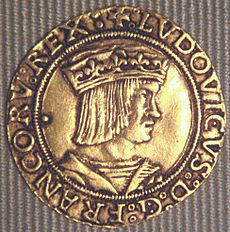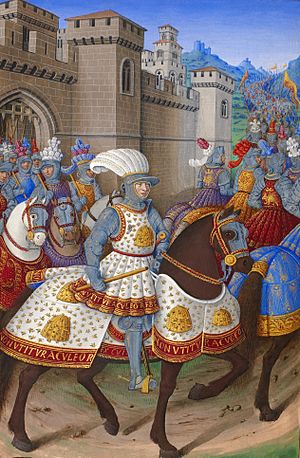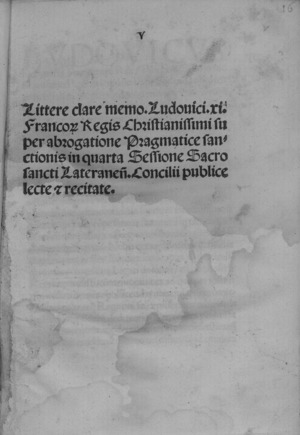Louis XII facts for kids
Quick facts for kids Louis XII |
|
|---|---|
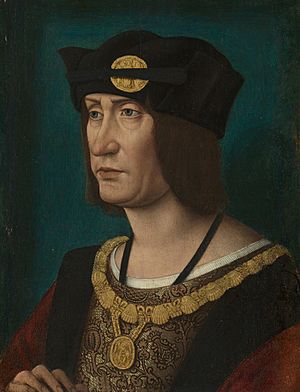
Portrait by workshop of Jean Perréal, c. 1514
|
|
| King of France (more...) | |
| Reign | 7 April 1498 – 1 January 1515 |
| Coronation | 27 May 1498 |
| Predecessor | Charles VIII |
| Successor | Francis I |
| Duke of Milan | |
| Reign | 6 September 1499 – 16 June 1512 |
| Predecessor | Ludovico Sforza |
| Successor | Massimiliano Sforza |
| King of Naples | |
| Reign | 2 August 1501 – 31 January 1504 |
| Predecessor | Frederick |
| Successor | Ferdinand III |
| Born | 27 June 1462 Château de Blois |
| Died | 1 January 1515 (aged 52) Hôtel des Tournelles |
| Burial | 4 January 1515 Saint Denis Basilica |
| Spouse |
Joan of France
(m. 1476; ann. 1498) |
| Issue among others... |
Claude, Queen of France Renée, Duchess of Ferrara |
| House | Valois-Orléans |
| Father | Charles, Duke of Orléans |
| Mother | Marie of Cleves |
Louis XII (born June 27, 1462 – died January 1, 1515) was the King of France from 1498 to 1515. He was also the King of Naples for a few years, from 1501 to 1504. Louis was the son of Charles, Duke of Orléans. He became king after his cousin, Charles VIII, passed away without any children in 1498.
Before becoming king, Louis was known as Louis of Orléans. He was forced to marry his cousin, Joan, by King Louis XI. Joan was unable to have children. King Louis XI hoped this marriage would prevent Louis's family line from having a claim to the throne.
Louis of Orléans was a powerful noble who opposed the French monarchy in a conflict called the Mad War. He was captured in 1488 during the Battle of Saint-Aubin-du-Cormier. However, King Charles VIII forgave him and set him free. Louis then joined Charles VIII in the Italian War of 1494–1498 as a military leader.
When Louis XII became king in 1498, he had his marriage to Joan officially ended by Pope Alexander VI. This is called an annulment. He then married Anne of Brittany, who was the widow of his cousin Charles VIII. This marriage helped to keep the region of Brittany connected to France.
Louis continued the Italian Wars. He started a second campaign to gain control of the Kingdom of Naples. Louis conquered the Duchy of Milan in 1500. He then moved on to the Kingdom of Naples, which he took over in 1501. Even though he was declared King of Naples, Louis faced a new group of enemies led by Ferdinand II of Aragon. He was forced to give up Naples to Spain in 1504.
Unlike many French kings, Louis XII did not try to take away power from local governments or nobles. He was a popular king and was called "Father of the People" (French: Le Père du Peuple) in 1506. This title was given to him by the Estates-General (a meeting of representatives from different parts of society) in Tours. He earned this title because he lowered a tax called the taille, made legal improvements, and brought peace to France.
Louis remained the Duke of Milan after the second Italian War. He wanted to expand his power further in Italy. He launched a third Italian War (1508–1516). This war was known for the bravery of the knight Chevalier de Bayard.
Louis XII passed away in 1515 without a son to take his place. His cousin and son-in-law, Francis, from a different branch of the Valois family, became the next king.
Contents
Early Life and Rise to Power
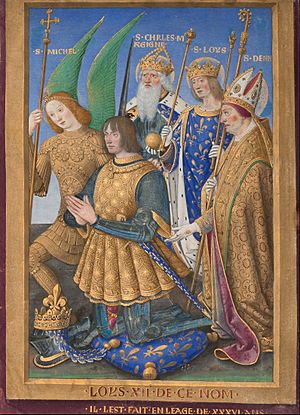
Louis d'Orléans was born on June 27, 1462, at the Château de Blois in France. His parents were Charles, Duke of Orléans, and Marie of Cleves. His father was nearly 70 years old when Louis was born. Louis became the Duke of Orléans at just three years old when his father died in 1465.
King Louis XI, who became king in 1461, did not trust the Orléans family. He did not want a member of their family to become king of France. Despite his doubts, King Louis XI became Louis's godfather.
King Louis XI died on August 30, 1483. His 13-year-old son, Charles VIII, became the new king. Charles VIII's older sister, Anne, served as his regent, meaning she ruled until he was old enough. In January 1484, a meeting called the Estates General took place in Tours, France. People from three different groups, or "estates," attended.
- The First Estate represented the Church.
- The Second Estate was made up of nobles and royalty.
- The Third Estate included common people, traders, and merchants.
Louis, as the Duke of Orleans, attended as part of the Second Estate. Each group presented their concerns and ideas for the new king's policies.
The Church wanted to bring back the "Pragmatic Sanction." This rule, started by King Charles VII, meant that the Pope could not appoint bishops and abbots in France. Instead, the King of France would make these appointments.
The nobles wanted to prevent foreigners from leading the military. The merchants wanted taxes to be greatly reduced. They also wanted the government to save money by cutting royal pensions and reducing the number of government jobs. All three groups agreed that the sale of government jobs should end.
The King left Tours on March 7, 1484, due to poor health. Five days later, the representatives were told there was no more money to pay them. The Estates General ended without many immediate changes. However, many of the ideas discussed there would later be put into action when Louis XII became king.
From 1485 to 1488, Louis fought against the royal authority in a conflict known as the Mad War. He allied with Francis II, Duke of Brittany. Louis's forces were defeated at the Battle of Saint-Aubin-du-Cormier on July 28, 1488, and he was captured. Three years later, he was pardoned and joined King Charles VIII in his military campaigns in Italy.
King Charles VIII had no surviving children. According to French law (called Salic Law), only male descendants could inherit the throne. This made Louis, who was a great-grandson of King Charles V, the closest male relative to inherit. So, Louis, Duke of Orleans, became King Louis XII on April 7, 1498, after Charles VIII's death.
King Louis XII's Reign
Reforming France's Government
Even though he became king later in life and unexpectedly, Louis XII was a very active ruler. He worked hard to improve France. He reformed the legal system, lowered taxes, and made the government better, much like King Henry VII did in England. To balance his budget after cutting taxes, Louis XII reduced the payments given to nobles and foreign princes.
In terms of religion, Louis XII brought back the Pragmatic Sanction. This rule gave the King of France, or other French officials, most of the power to appoint leaders in the Roman Catholic Church in France. These reforms had been suggested at the Estates General meeting in 1484.
Louis was also good at managing the powerful noble families, including the Bourbon family. This helped make the French government more stable. He expanded the powers of royal judges and tried to stop corruption in the law. He also made French customary law clearer and officially approved it. He improved the tax collection system, requiring tax collectors to send all money to the government within eight days. Those who broke this rule faced fines or lost their jobs.
Early Military Campaigns
In 1494, the French Kingdom under Charles VIII invaded Italy. They wanted to protect the Duchy of Milan from the Republic of Venice. Milan was one of the richest parts of Europe at the time. Louis, then Duke of Orleans, joined Charles VIII in this campaign. The French were helping Ludovico Sforza, the Duke of Milan. This invasion started a series of wars called the "Italian Wars," which lasted until 1559.
In 1495, Ludovico Sforza turned against the French. He joined the anti-French League of Venice. This left Louis, the Duke of Orleans, in a difficult military situation at the Battle of Fornovo on July 6, 1495. Because of this, Louis came to dislike Ludovico Sforza. Even before he became king, Louis claimed the Duchy of Milan as his own. He believed it belonged to him through his grandmother, Valentina Visconti.
After becoming king in 1499, Louis XII pursued his goal to claim Milan. This led to the "Great Italian War" (1499–1504). Before starting the war, Louis needed to deal with other countries. In August 1498, he signed a peace treaty with Maximillian I of the Holy Roman Empire.
With Maximillian I no longer a threat, Louis focused on King Henry VII of England. Henry was trying to arrange a marriage between his son, Arthur, and Catherine of Aragon of Spain. Louis needed to separate Spain from England before dealing with Henry VII. Spain was also part of the anti-French League of Venice. Ferdinand II of Aragon, the king of Spain, was very hostile towards France. In August 1498, Louis XII managed to sign a treaty with Spain. It ignored their land disputes and promised friendship and peace.
This gave Louis XII enough freedom to make an alliance with Scotland. Louis wanted to restart the Auld Alliance between France and Scotland, which had existed since 1309. In early 1499, the alliance was renewed. This made England focus on Scotland instead of continental Europe.
With other major powers busy or at peace with France, Louis XII could focus on two other neighbors: the Swiss Confederation and the Duchy of Savoy. In March 1499, Louis signed an agreement with the Swiss. He promised them 20,000 francs each year if they allowed France to recruit soldiers from their country. In return, Louis promised to protect the Swiss from Maximillian and the Holy Roman Empire. Louis also made a deal with the Duchy of Savoy by May 1499. This allowed French troops to cross Savoy to reach Milan. It also allowed France to buy supplies and recruit soldiers in Savoy. Finally, Louis was ready to march into Italy.
The French army had been strong when Charles VIII first invaded Italy in 1494. However, it had weakened due to neglect. Louis XII had been rebuilding the French army since he became king. Now, he could use it.
On August 10, 1499, the French army entered the Duchy of Milan. The army was led by Gian Giacomo Trivulzio, a Milanese-born marshal who served the French king. This army had 27,000 men, including 10,000 mounted soldiers and 5,000 Swiss mercenaries. The French army surrounded the town of Rocca di Arazzo. After five hours of bombing, the town's walls were broken, and the French took it. Louis XII ordered his army to kill the soldiers and many civilians in Rocca di Arazzo. This was a warning to other towns not to resist the French. The French did the same at Annone, the next town. This time, it worked, and three more towns surrendered without a fight.
Marshal Trivulzio learned that the Venetian army, allies of Milan, were coming to help. So, he marched his army to Pavia, the last fortified town in Milan. With French troops close to Milan, Lodovico Sforza decided it was useless to fight. On the night of September 2, 1499, Sforza and some cavalry fled Milan, heading north. Louis XII, who was in Lyon, heard about Milan's surrender on September 17, 1499. He immediately went to Milan and made a grand entry on October 6, 1499. Marshal Trivulzio gave Louis the key to the city. Louis then made Trivulzio the temporary French governor of Milan. Later, Georges d' Amboise became the permanent governor. To gain popularity, Louis lowered the old Sforza taxes by a third.
Meanwhile, Ludovico Sforza gathered an army, mostly Swiss soldiers, to retake Milan. In mid-January 1500, his army crossed into Milan and marched towards the city. Some of his supporters in Milan rose up. On February 1, 1500, Marshal Trivulzio decided he could not hold the city, and the French retreated. Sforza was welcomed back into Milan by a joyful crowd on February 5, 1500.
Louis XII sent another army under Louis de La Trémoille to recapture Milan. By the time Trémoille reached the French forts near Milan, his army had grown to 30,000 men, including many Swiss mercenaries. The Swiss government heard about the coming battle and forbade any Swiss soldier from fighting against another Swiss. This meant all Swiss soldiers left both armies and went home. This hurt Sforza's army more, as it had a larger number of Swiss soldiers.
Facing the returning French army and his much smaller force, Sforza decided to leave Milan again. This time, however, Sforza was captured and spent the rest of his life in a French prison. Even though Milan had welcomed Sforza back (which Louis XII saw as "treason"), Louis XII was very generous to the city after his victory. When Sforza was in charge, grain export was forbidden. The French reopened the grain trade, which led to ten years of prosperity in Milan. Milan remained a French stronghold in Italy for twelve years.
Using Milan as his base, Louis XII turned his attention to other parts of Italy. The city of Genoa agreed to have Philip of Cleves, Louis XII's cousin, as its new governor. The French king also began to claim the Kingdom of Naples. This claim was not as strong as his claim to Milan, as it only came from him being Charles VIII's successor. Still, Louis XII strongly pursued this claim.
French soldiers left over from Charles VIII's first invasion gave Louis XII a foothold in southern Italy. He hoped to use this to enforce his claim to Naples. However, Louis first had to deal with a problem in northern Italy. In 1406, Florence conquered Pisa, but Pisa had been rebelling ever since. In 1494, the Pisans successfully overthrew the Florentine governors. The Florentines asked France for help to retake Pisa, as Florence had long been an ally of France. However, Louis and his advisors were annoyed because Florence had stayed neutral in the recent fight against Sforza. The French knew they would need Florence for the Naples campaign, as French troops would need to cross Florentine territory.
So, a French army, including 600 knights and 6,000 Swiss soldiers, led by Sire de Beaumont, was sent to Pisa. On June 29, 1500, French and Florentine forces surrounded Pisa. Within a day, French cannons broke down 100 feet of the city's old walls. Even with the broken walls, the Pisans fought so hard that Beaumont gave up on taking Pisa. On July 11, 1500, the French left and went north. This failed attempt at Pisa made opponents of the French in Italy bolder. Claiming the Kingdom of Naples became politically impossible until some of these opponents were dealt with. Spain was one such opponent. In 1500, Louis XII discussed his claim to Naples with Ferdinand II of Aragon, King of Aragon, and Queen Isabella I of Castile of Spain.
On November 11, 1500, Ferdinand II and Louis XII signed the Treaty of Granada. This treaty brought Spain into Italian politics in a major way for the first time. Louis XII was criticized for this by historians like Niccolò Machiavelli. Machiavelli's criticism of Louis XII is in his famous book The Prince.
Military Campaigns in Naples (1501–1508)
To claim his half of the Kingdom of Naples, Louis XII sent an army in early June 1501. It was led by Bernard Stuart of Aubigny and included 1,000 knights and 10,000 foot soldiers, with 5,000 Swiss troops. In May 1501, Louis got permission for his troops to march through Bologne on their way to Naples. As the army neared Rome, Spanish and French ambassadors told Pope Alexander VI about the secret Treaty of Grenada, signed November 11, 1500. This treaty divided the Kingdom of Naples between France and Spain. The Pope was pleased and officially declared Louis XII of France and Ferdinand II of Spain as his vassals (rulers under his authority) in Naples. King Frederick of Naples learned about his fate and betrayal by his own cousin, Ferdinand, from this public announcement.
Lord Stuart kept his troops very disciplined during most of the march to Naples. However, discipline broke down when the army passed through Capua. The French army looted Capua without mercy. But when news of the attack on Capua spread, resistance to the French in southern Italy disappeared. Frederick fled, and the French Army entered Naples without a fight. Louis XII claimed the throne of Naples. As agreed with Ferdinand II, he shared half of Naples' income with Spain. However, as Machiavelli had predicted, the agreement did not last. By early 1502, relations between France and Spain had worsened. Negotiations began to resolve their disagreements about Naples. But in April 1502, without waiting for the talks to finish, Louis sent an army under Louis d' Armagnac, Duke of Nemours against the Spanish in Apulia.
The War of the League of Cambrai
Louis's biggest success came in the War of the League of Cambrai (1508–1516). This was his last war, fought against the Venetians, who had become his enemies again. The French army won the Battle of Agnadello on May 14, 1509. However, things became much harder in 1510 when the army of Pope Julius II got involved. Julius II created the Holy League specifically to stop France's ambitions. The French were eventually driven out of Milan in 1513 by the Swiss.
Using Propaganda to Promote the King
Under Louis XII, there was a huge increase in propaganda and publicity for the French crown. Louis XII held many large ceremonies for marriages, funerals, and other important events during his reign. These events gave Louis chances to show off royal power and make himself look important. This was often done through iconography (using symbols and images). Also, as royal images spread throughout the kingdom, writers, encouraged by Louis's lack of censorship, wrote praises about their king.
Louis adopted the porcupine as his personal symbol and as a royal animal. Because of this, the popularity of the porcupine exploded. You could find porcupines in illuminated manuscripts (decorated books), on buildings, and even on cannons. People at the time believed that porcupines could shoot their quills. So, the porcupine symbolized the king's ability to attack and defend. During his years of conquest, Louis presented his kingdom to the public as a porcupine – a creature supposedly unbeatable and feared by all. However, in the second half of his reign, Louis began to use the porcupine more as a simple symbol for identification. He wanted to appear as a religious and honorable king to the public. Louis adopted titles like Father of the People and compared himself to figures like St. Louis. This helped show his commitment to justice and reform, rather than just military power.
Louis's first initial, L, was often decorated with an open royal crown and fleurs-de-lys (a lily symbol). Also, Louis's personal colors were red and yellow (or gold). So, guard uniforms, book designs, and flags often featured Louis's royal colors and his initial.
Louis also made state portraits popular as a way to spread his image. He hired many artists to paint him and create small, detailed portraits that can still be found in old books today. His propaganda efforts grew even more with the creation of portrait coins, which were first made in France in 1514.
Louis XII's Legacy
During Louis's reign, the region of Brittany became a permanent part of France. This was not legally completed until 1547. By the end of his reign, the government's debt was no larger than when he became king in 1498, even after several expensive wars in Italy. His financial reforms in 1504 and 1508 improved how taxes were collected.
Despite some military and diplomatic setbacks, Louis was a popular king. Historians often say his popularity came from his tax reduction policies. While Francis I later raised taxes, Louis's changes to law codes and the creation of new courts (called parlements) had a longer-lasting impact. He truly earned the title Father of the People ("Le Père du Peuple") given to him by the Estates General in 1506. This was the first and only time a French king received this special title.
Family Life
Marriages and Children
-
Mary Tudor during her brief period as Queen of France
In 1476, King Louis XI (his cousin) forced Louis to marry his daughter, Joan of France. Charles VIII (Louis XI's son) became king in 1483. When Charles died childless in 1498, Louis XII became king. Charles had been married to Anne, Duchess of Brittany, to unite the independent Duchy of Brittany with France. To keep this union strong, Louis XII had his marriage to Joan annulled in December 1498, after he became king. This allowed him to marry Charles VIII's widow, Anne of Brittany.
The annulment was complicated. Louis argued that he was forced to marry Joan by her father, Louis XI. Pope Alexander VI agreed to the annulment for political reasons. Joan reluctantly accepted, saying she would pray for her former husband. She became a nun and was later recognized as a saint in 1950.
Louis married Anne, who was not eager for the marriage, in 1499. Anne gave birth to two daughters. The older daughter, Claude (1499–1524), was promised to the future Emperor Charles V in 1501. But Anne did not have a living son. So, Louis ended Claude's engagement to Charles V. Instead, he promised Claude to his heir, Francis of Angoulême. This made sure that Brittany would stay united with France. Anne was against this marriage, which only happened after her death in 1514. Claude inherited Brittany from her mother and became queen to Francis. The younger daughter, Renée (1510–1575), married Duke Ercole II of Ferrara.
After Anne's death, Louis married Mary Tudor, the sister of Henry VIII of England. They married in Abbeville, France, on October 9, 1514. This was a final attempt to have a son to inherit his throne, as he had no living sons from his previous marriages. Louis died on January 1, 1515, less than three months after marrying Mary. They had no children, so the throne passed to Francis I of France, who was Louis's cousin and also his son-in-law.
Death and Succession
On December 24, 1514, Louis was reportedly suffering from a severe case of gout. In the early hours of January 1, 1515, he received his last religious rites and died later that evening. On January 11, Louis's body was taken to Notre-Dame for a funeral mass. The next day, during the funeral procession, the cart carrying the coffin broke down. Louis was buried in Saint Denis Basilica. His tomb is known as the Tomb of Louis XII and Anne of Brittany.
The French throne followed Salic Law, which meant women could not inherit the crown. Because of this, Louis XII was succeeded by Francis I. Francis was born on September 12, 1494, to Louise of Savoy and Charles, Count of Angoulême. Francis also married Louis XII's eldest daughter, Claude of France.
The Duchy of Brittany had a different tradition, allowing women to inherit the crown. Anne of Brittany died before Louis XII. So, Anne's eldest daughter, Claude of France, inherited the Duchy of Brittany directly before Louis's death. When Claude married Francis I, Francis also became the administrator of Brittany through his wife. This ensured that Brittany would remain part of the Kingdom of France and that the kingdom would stay united.
Honors and Recognition
 Kingdom of France – Grand Master of the Order of Saint Michael
Kingdom of France – Grand Master of the Order of Saint Michael Kingdom of France – Duchy of Orléans : Last Grand Master and Knight of the Order of the Porcupine
Kingdom of France – Duchy of Orléans : Last Grand Master and Knight of the Order of the Porcupine
Louis XII in Media
- As Duke of Orleans, he appears in Sir Walter Scott's 1823 novel Quentin Durward. In the book, he tries to end his marriage to Joan.
- Louis is played by English actor Joseph Beattie in the Borgia (TV series) on Canal+. He continues Charles VIII's claim on Naples and is crowned Duke of Milan by Cesare Borgia. Although he is initially friends with Cesare, their relationship becomes difficult due to Cesare's conflicts with French interests and his harsh methods. After della Rovere becomes Pope Julius II and Cesare's power declines, Louis offers him exile in France.
- The first season of The Tudors TV series includes a storyline loosely based on Louis's last marriage. Mary is renamed Margaret to avoid confusion with her niece, Mary I. The show changes some political details. The first season starts with Francis I already as King of France. To include Mary's short royal marriage and secret remarriage, the writers added a King of Portugal as her husband, who is not like the real King of Portugal at that time. The marriage is still very short, as 'Margaret' smothers her husband with a pillow.
See also
 In Spanish: Luis XII de Francia para niños
In Spanish: Luis XII de Francia para niños


